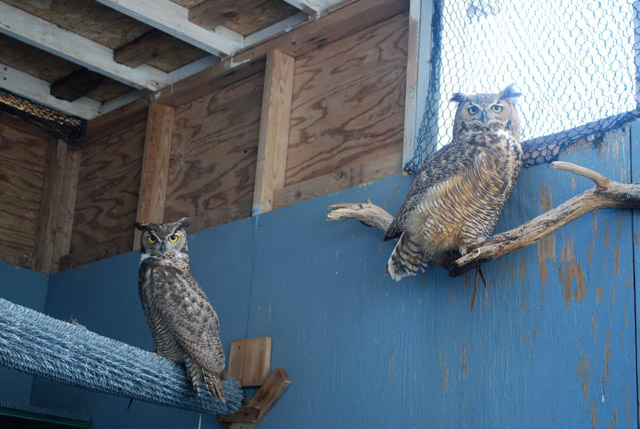Injured Birds Find Sanctuary in Ojai
Raptor Center Rehabilitates Wildlife, Especially the Feathered Kind

Sasquatch is a robust red-tailed hawk that will never be able to fly because he was confined to a small cage for a large part of his development and fed hamburger. It took six weeks of intensive physical therapy before he could perch; he had to build the relatively nonexistent muscles in his legs, according to Kimberley Stroud, director of the Ojai Raptor Center.
The center strives to prevent sad stories like that of Sasquatch by focusing on rehabilitation.
“The end goal is always release, and we have about a 60 percent release rate,” Stroud said.
Networked with California Fish and Game, humane societies, and other animal-welfare groups around the country, the Raptor Center can take in as many as 1,300 animals a year. This is not limited to birds of prey. The center is licensed to rehabilitate animals ranging from opossums to mountain lions, but “birds of prey are my passion,” said Stroud.
The center has two types of birds: those that are named and those that are not named. Those that are not named are actually the fortunate ones, the ones with hopes of again flying free. The goal is to rehabilitate them, Stroud said, not to make them seem like pets. “Our ultimate goal is to reduce common hazards to wildlife and decrease the numbers that require our help,” she added.
The named birds are less lucky—like Lucky, the red-shouldered hawk, who is unable to be released because she was raised by humans and fed steak, crippling any chance of personal survival due to her inability to hunt and her identification with humans. According to the Ojai Raptor Center, named, non-releasable birds (the ones that are not relocated) are used for educational purposes. Staff and volunteers take them into schools where the birds “illustrate behavior, characteristics, and essential roles that the species plays in its natural habitat,” said Stroud.
Dakota and Newton, dignified great-horned owls, are two more educator-birds. “People tried to keep them as pets and then they imprinted on people,” Stroud explained. They don’t even recognize their own species, she said. “If we let these birds out into the wild they would starve or find people to go to for food.”
According to the Audubon Society of America, “Imprinting is a term that describes how many animals decide ‘who they are.’ It is a critical behavioral process in a growing animal and occurs during a period in which the young establish the concept of ‘parent’ and ‘self.’” So Dakota and Newton imprinted on their human owners and identify with humans as a result.
“He builds me a nest every year and wants to breed,” said Stroud about another resident housed at a satellite of the center: a black-crowned night heron. With severe metabolic bone disease and arthritis, this bird never would have survived in the wild.
The center takes all possible measures to preempt imprinting: Both named and unnamed resident birds serve as surrogate parents for new arrivals. This gives the baby birds a relatively normal upbringing and a vastly improved chance of surviving in the wild. “Imprinting is the most preventable disease,” said Stroud. They are fed live prey so they can hone their hunting skills.
The birds are turned in for a variety of reasons, according to Stroud. Needy birds can be turned in by anyone from individuals to animal control, and the center is going to work hard on their rehabilitation. Physical problems like broken wings or eye problems can often be resolved by the center’s savvy veterinarians.
When the birds are ready for release, the center “looks for a habitat and a food source, and takes territory into account” to prevent any danger of eco-system disruption or territorial struggles, said Stroud. Two fortunate eagles hailing from Bishop were returned to their home territory in private planes.
The center is situated in the lush, rural landscape of Ojai: “This is such a great spot. There’s so much wildlife,” Stroud said as she watched two wild red-tailed hawks fly serenely around their nest in a nearby tree. “That is always the goal!” she beamed.
The current location is a part of a former jail complex now owned by the nonprofit social service agency HELP of Ojai. But a large part of what the Raptor Center is using for its lab and hospital wing are a former pig barn. “It’s taken three years of our operating budget to renovate the place. I mean—it was a pig barn,” said Stroud. “But the lease is 30 years, so we are here for the long term.”
“We hope to build a landscape barrier so the freeway is blocked from view, but we are trying to keep all the plants native,” said Stroud. Many of the materials, vet racks, and landscaping were donated, but the place has a need for facility and garden improvements.
To truly keep the birds wild, the center is not open to the public, but it does take volunteers under its wing. The next volunteer training session is March 5, from 1 to 3 p.m. at the Ojai Raptor Center.



